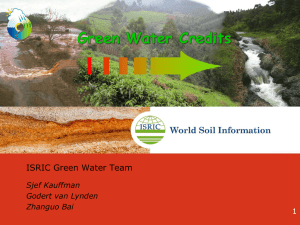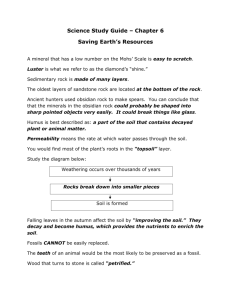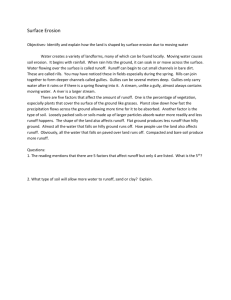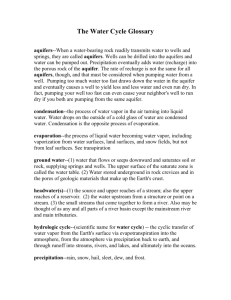Hydrology Modeling in Alaska: Model Documentation Template
advertisement
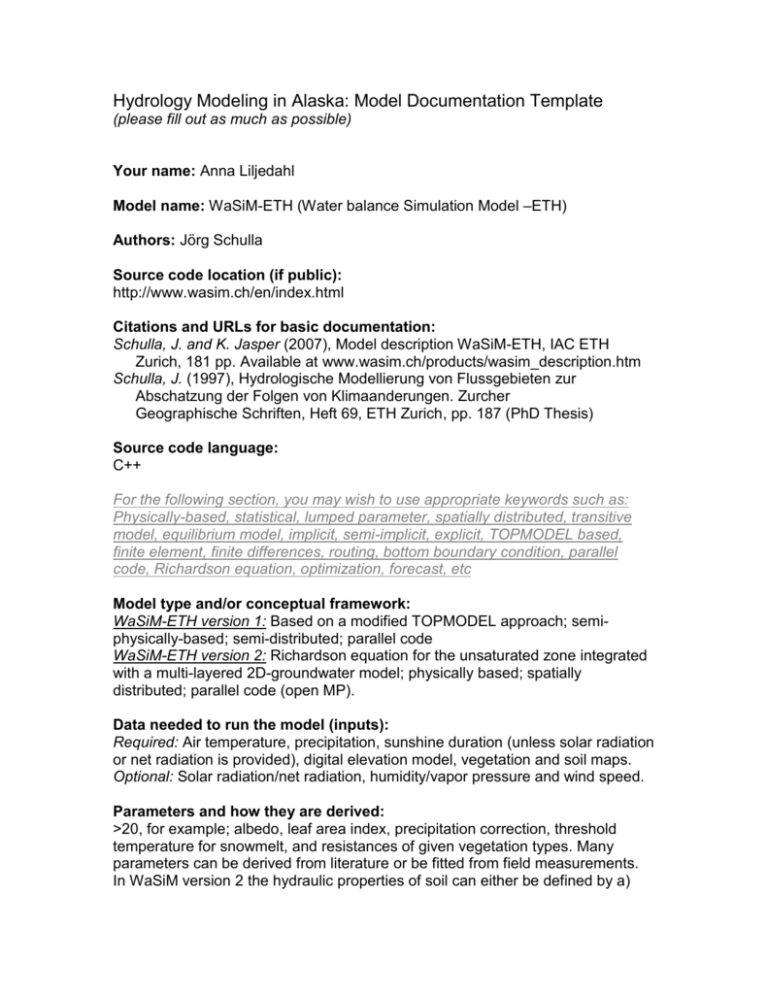
Hydrology Modeling in Alaska: Model Documentation Template (please fill out as much as possible) Your name: Anna Liljedahl Model name: WaSiM-ETH (Water balance Simulation Model –ETH) Authors: Jörg Schulla Source code location (if public): http://www.wasim.ch/en/index.html Citations and URLs for basic documentation: Schulla, J. and K. Jasper (2007), Model description WaSiM-ETH, IAC ETH Zurich, 181 pp. Available at www.wasim.ch/products/wasim_description.htm Schulla, J. (1997), Hydrologische Modellierung von Flussgebieten zur Abschatzung der Folgen von Klimaanderungen. Zurcher Geographische Schriften, Heft 69, ETH Zurich, pp. 187 (PhD Thesis) Source code language: C++ For the following section, you may wish to use appropriate keywords such as: Physically-based, statistical, lumped parameter, spatially distributed, transitive model, equilibrium model, implicit, semi-implicit, explicit, TOPMODEL based, finite element, finite differences, routing, bottom boundary condition, parallel code, Richardson equation, optimization, forecast, etc Model type and/or conceptual framework: WaSiM-ETH version 1: Based on a modified TOPMODEL approach; semiphysically-based; semi-distributed; parallel code WaSiM-ETH version 2: Richardson equation for the unsaturated zone integrated with a multi-layered 2D-groundwater model; physically based; spatially distributed; parallel code (open MP). Data needed to run the model (inputs): Required: Air temperature, precipitation, sunshine duration (unless solar radiation or net radiation is provided), digital elevation model, vegetation and soil maps. Optional: Solar radiation/net radiation, humidity/vapor pressure and wind speed. Parameters and how they are derived: >20, for example; albedo, leaf area index, precipitation correction, threshold temperature for snowmelt, and resistances of given vegetation types. Many parameters can be derived from literature or be fitted from field measurements. In WaSiM version 2 the hydraulic properties of soil can either be defined by a) “look-up-tables” which only requires information of saturated hydraulic conductivity or b) by applying the Van Genuchten [1976] method. Spatial element used to lump inputs and outputs: A grid, which resolution is based upon the resolution of the DEM or the network density of the meteorological stations. The soil map and vegetation cover grid must have the same grid cell size as the DEM. Sub-models (i.e. snow or ground thermodynamics): Static active layer algorithm, snow accumulation (1-D), snow melt (temperature index or temperature-wind-index or combination approach based upon Anderson [1973] and Braun [1985]). The active layer model is described by: The number of snow free days is calculated on a cell by cell basis. Snow-free days are defined by a snow cover below a threshold snow water equivalent (SWEmin). To account for short periods of snow accumulation during the thawed period, a period of up to nsc,min days will not be considered for refreezing but also not for thawing. If the number of consecutive days with a snow cover above the threshold SWEmin is longer than the number given in nsc,min then the soil is assumed to be frozen again and dthaw and nsf is reset to 0. Additional sub-models: Radiation correction, precipitation correction, input data interpolation, evapotranspiration (soil evaporation and plant transpiration), glacier melt and runoff (incl. routing within the glacier), interception, performance criteria runoff statistics, lake, irrigation and pumping, tracer and salt transport, multilayered vegetation, plant phenology, macropore runoff, and silting-up. A dynamic time step control algorithm is implemented in the Richard’s model. Also, WaSiM can be one-way-coupled to a climate model and downscale the climate model simulations. WaSiM can be coupled to an external model allowing online data exchange. An example of the latter was a coupling to the groundwater model PCGEOFIM. Rainfall/runoff transformation mechanism: See below Runoff routing within spatial elements and to basin outlet: WaSiM-ETH version 1 (TOPMODEL approach): The modeling of the soil water balance and runoff generation is done using a modified variable saturated area approach after Beven and Kirkby [1979] extended by capillary rise and interflow. Baseflow - generated for an entire basin as an average value based upon topographic index, saturation deficit and a recession parameter; Interflow - generated for each grid cell separately and then averaged over space and requires a sufficient slope and a completely saturated soil; Surface runoff - routed to the sub-basin outlet using a subdivision of the basin into flow time zones. Surface runoff is the sum of snowmelt runoff, runoff due to infiltration excess and runoff from saturated areas. The discharge routing is based on hydraulic calculation of flow velocities using the kinematic wave approach. WaSiM-ETH version 2 (Richard’s approach): Numerical solutions are used to represent vertical fluxes, interflow and infiltration/exfiltration in rivers. Vertical fluxes - A 1-D finite difference scheme is applied to the unsaturated zone, where the upper boundary condition is estimated after Green and Ampt [1911] and the lower boundary is the groundwater table that is constant for each time step but variable in time. Surface routing - Four options; a) multiple/single flow path(s) based upon DEM (static flow direction) and b) multiple/single flow path(s) based upon water table (dynamic flow direction). Channel routing: Translation-retention approach using hydraulic parameters for pre-defined channel cells. Method for including sub-grid scale processes: WaSiM-ETH version 1 (TOPMODEL approach): Spatially distributed soil moisture is calculated using the topographic index for each grid cell opposed to modeling classes of similar indices as in the original TOPMODEL. Resolution (possible & prudent): Meter to kilometers (geographical), down to centimeters (soil column), hourly to monthly. Method of deriving topography: Digital elevation model Calibration approaches: The most important parameters are usually the parameters of the soil model, where Version 1 (TOPMODEL approach) requires calibration of nine while Version 2 may be calibrated on three soil parameters. It is recommended to use at least measured runoff for the model calibration. In addition, soil moisture, groundwater tables or snow water equivalents is advantageous in the calibration process. A detailed description of how to approach the calibration is given in Schulla and Jasper [2007]. Treatment of frozen ground: Reduced/limited hydraulic conductivity. Publications using this model: Over 30 peer-reviewed publications. Publications, dissertations and reports prior to 2008 are available at http://www.wasim.ch/en/dialog/publications.htm Strengths and Weaknesses in Alaska applications: - No published applications to permafrost regions - No dynamic representation of soil thermal regime (fixed ground heat flux) - Requires multiple parameters + Multiple options of varying complexity in representing a hydrological process (i.e. evapotranspiration, snow melt, sub-surface hydrology) + Air temperature and precipitation is the only required meteorological input data + Plant physiological control on evapotranspiration + The unsaturated zone is represented by the Richard’s equation + Can represent storage and spilling from lakes + Includes a simple active layer algorithm + Includes a glacier hydrology model + Could be coupled to a snow distribution model and a soil thermal regime model

